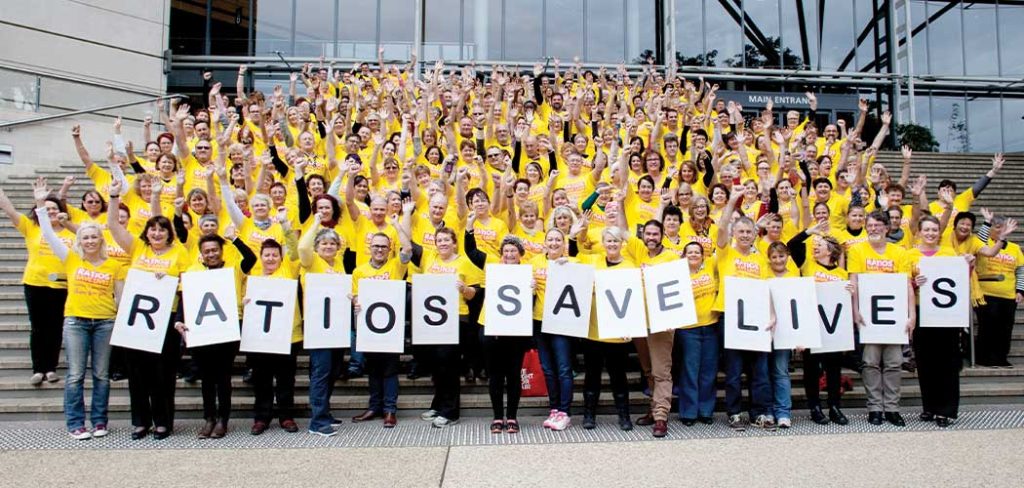Australian nurses and midwives have been trailblazers in fighting for and securing nurse/midwife patient ratios, demonstrating to the world the power of political activism and sheer dogged determination.
As the ANMF marks its 100-year anniversary, we celebrate this achievement and recognise the jurisdictions that paved the way.
Arguably, the fight to secure and maintain ratios in the interests of patient care has driven nurses and midwives to picket lines and marches, to protest and take protected industrial action, more than any other issue. Evidence shows that the number of patients allocated to a nurse or midwife on a shift is directly related to patient safety and mortality, and the quality of care patients receive.
The ANMF Victorian Branch and the Queensland Nurses and Midwives’ Union (QNMU, ANMF Queensland) succeeded in historic campaigns to mandate minimum nurse: patient ratios as their safe staffing model. The ANMF ACT Branch is on the brink of getting babies counted in maternity ratios in their current enterprise bargaining agreement, which will make them only the second Australian state to do so after Queensland.
Other Australian jurisdictions have begun (Western Australia), are about to introduce (New South Wales), or are in negotiations with their state governments for the introduction of nurse: patient ratios (South Australia, Tasmania), while Northern Territory nurses and midwives continue their fight.
Victoria
In Victoria, nurse: patient ratios were introduced in 2000 through the nurses’ and midwives’ enterprise agreement. It followed a tumultuous time in the state with the decimation of the nursing workforce under the conservative Kennett government during that decade. The ANMF Victorian Branch launched its 1:4 ratios campaign in the 1990s for one nurse for four patients in a hospital ward during a day shift.
Ratios were established to ensure that patients received adequate care by setting minimum nursing and midwifery staffing requirements in certain publicly funded health facilities.
In October 2015, the then Andrews Government made history and Victoria’s nurses and midwives celebrated as nurse/midwife: patient ratios became law. With the passing of the Safe Patient Care Act 2015 Victoria became only the second jurisdiction in the world to legislate nurse/midwife to patient ratios.
The legislation was the result of a promise kept by the Andrews Government – prior to the 2014 election, then-Opposition Leader Daniel Andrews visited ANMF Victorian Branch and committed to legislating ratios if the Labor Party secured government.
For ANMF Victorian Branch members, the landmark legislation meant an end to patient loads for nurses and midwives in the public sector being used by governments as a bargaining chip in enterprise agreement negotiations.
“With this legislation, we will never again have to fight to keep ratios,” said ANMF Victorian Branch Secretary Lisa Fitzpatrick.
“There is clear evidence linking nurse/midwife: patient ratios with improved patient safety and better care – this is the bedrock of nursing and midwifery – and what matters to nurses and midwives as health professionals.”
The introduction of ratios in 2000 into the Victorian public health system provided a huge boost to morale within the nursing and midwifery professions at a time when it was sorely needed. Further changes to the Safe Patient Care Act have added new and improved nurse/midwife: patient ratios to the Victorian public health system including the abolishing of the 50 per cent rule.
Queensland
In January 2015, the Queensland Nurses and Midwives’ Union launched its Ratios Save Lives campaign to legislate minimum nurse/midwife: patient ratios as an evidence-based, cost-effective way to improve the safety and quality of healthcare in Queensland.
The campaign was welcomed by nurses, midwives and the wider community, so much so the then Palaszczuk Government committed to legislating minimum ratios in acute medical and surgical wards and two mental health wards across Queensland Health.
On 1 July, 2016, Queensland Health implemented legislation establishing nurse: patient ratios in 27 prescribed public facilities across the state – making Queensland the fourth government in the world to make nurse: patient ratios law.
Legislated ratios specified an average of 1:4 on morning/afternoon shifts and 1:7 on night duty in prescribed acute adult medical/surgical wards.
The historic moment for nursing and midwifery in Queensland marked the delivery of safe, high-quality healthcare. A subsequent study in Queensland found legislated nurse: patient ratios had positive effects on nurse staffing and patient outcomes, including mortality, readmissions and length of stay.

“The successful implementation of ratios in Queensland Health medical and surgical wards shows nurse insight can save lives and valuable tax dollars,” said then-QNMU secretary Beth Mohle.
In 2020, the QNMU launched its Count the Babies campaign. After years of campaigning, the Queensland Government passed legislation in March 2024 that counts newborn babies in numbers. Under the new law, Queensland is the only state or territory in Australia to count both mothers and babies in midwifery ratios. The midwife: patient ratios will be rolled out in a staged approach up to 2026. Commencing in 2024, a 1:6 midwife: patient ratio will occur at public maternity wards that have high-level services.
NSW
Four historic statewide strikes in 2022 resulted in the establishment of a Safe Staffing Levels Taskforce in April 2023 by the incoming Labor government to pursue the introduction of ratios in the public health system. In February 2024, the New South Wales Nurses and Midwives’ Association (NSWNMA, ANMF NSW) secured agreement on the first phase of the ratios rollout, beginning at the Royal North Shore and Liverpool hospitals’ emergency departments.

For the first time, NSW will have minimum and enforceable shift-by-shift ratios in specific clinical areas of public hospitals, a major milestone in the NSWNMA’s longstanding fight for reform.
After more than a decade of campaigning, NSWNMA General Secretary Shaye Candish said the implementation of ratios meant patient safety would no longer be compromised. It was the reprieve that nurses and midwives so urgently needed.
“It will provide crucial workload relief for our members, who have been struggling with chronic understaffing for too long. It will also ensure our public hospitals are safer for patients, so they receive the care they deserve.”
ACT
The expansion of nurse/midwife: patient ratios in the ACT will make Canberra the second jurisdiction in Australia to include babies as part of minimum staffing levels for maternity services.
A 2020 Labor election commitment saw phase one of nurse: patient ratios delivered across general medical/surgical wards, acute aged care and mental health from February 2022.
Recent EBA negotiations between the government and ANMF ACT Branch will secure a second phase of ratios mandated across more wards, including intensive care, the emergency department, maternity, cancer services and palliative care. More than $86 million will be allocated to fund the required 137 fulltime nurse and midwife positions to be able to deliver ratios, over the next 18 months.
Other jurisdictions
The ANMF Tasmanian Branch proposed a ratios model for the state in 2016. Nurse/midwife: patient ratios have not been formally implemented in Tasmania, although the union and its members continue to advocate for safe staffing levels and the need for mandated ratios.
Meanwhile, the ANMF SA Branch is currently working with the state government on legislating nurse/midwife: patient ratios. The nurse/midwife: patient ratio committee, which includes members of the ANMF SA Branch and SA Health, has reached in-principle agreement for proposed SA ratio legislation, which has been sent to the Minister’s Office for approval. Additional staff and workforce planning will be required to meet the ratios. Commencement of ratio implementation will occur statewide by March 2026.
“Clearly there is much more work to be done but we will continue to engage with members in progressing this very important work. It will result in better workloads and safer patient care for our community,” said ANMF SA CEO/Secretary Adj Associate Professor Elizabeth Dabars AM.
In December 2022, the Western Australian government committed to phase in nurse: patient ratios in every public hospital within two years as part of an historic commitment to introducing ratios in the state. Perth Children’s Hospital (PCH) was the first in WA to begin implementing nurse/ midwife: patient ratios. In January 2024, the ANF Industrial Union of Workers Perth (ANFIUWP) accepted an industrial agreement which also formalises the state government’s commitment to nurse: patient ratios across the Western Australian health system, already underway at PCH.









